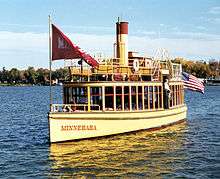Museum of Lake Minnetonka
| Museum ship | |
| Headquarters |
37 Water Street Excelsior, Minnesota |
| Website | http://www.steamboatminnehaha.org |
The Museum of Lake Minnetonka (MLM) is a 501(c)(3) nonprofit, all-volunteer organization based in Excelsior, Minnesota that formed during a restructuring of the Minnesota Transportation Museum (MTM) in 2004. The MLM's mission is to "preserve Lake Minnetonka's history through acquiring, restoring, and presenting items that help tell the story of the lake's colorful past." The museum's primary asset is the historic steamboat Minnehaha, which it operates regularly during the summer and autumn seasons.
Steamboat Minnehaha History


The Minnehaha was built by the Twin City Rapid Transit Company (TCRT) in 1906 as part of an "Express Boat" fleet that provided fast and reliable transportation for the residents of Lake Minnetonka during the early Twentieth century. She ran alongside her sister vessels Como, Harriet, Hopkins, Stillwater, and White Bear. TCRT had commissioned a naval architect named Royal C. Moore in 1905 to design these identical vessels. Each were 70 feet (21 m) long, 14 feet 10 inches (5 m) wide, drew 5 feet 7 inches (2 m) of water, and were powered by a single coal-fired boiler and triple-expansion steam engine with a single 46 inch (1,168mm) screw. Moore chose to use a launch-style hull for the craft, incorporating a torpedo stern into the design. This design, modern for the time, made the express boats exceptionally stable and efficient as they cut through the water at a cruising speed of approximately 12 miles per hour (19 km/h). Although the parts and materials for the express boats were initially prefabricated at Moore Boatworks in Wayzata, they were later sent to the TCRT streetcar shop in south Minneapolis to be assembled. From there the finished craft were transported to Excelsior via flatbed rail car and launched into Lake Minnetonka.
Service first began on May 25, 1906 from Minnetonka Beach. Later that year a transfer terminal where passengers could board a streetcar to Minneapolis was completed in Excelsior, and all routes (four in total) embarked and disembarked from there. The primary function assigned to the "streetcar boats," as they came to be known, was to provide fast and reliable transportation for the residents of Lake Minnetonka who commuted to work in Minneapolis and Saint Paul. The boats stopped at 26 designated landings around the lake and would also stop at private docks if flagged down with a white handkerchief. Since the boats were essentially an extension of TCRT's already extensive streetcar system, they were painted the same color as the company's streetcars and were furnished with many of the same fittings. As time passed several nicknames developed for the streetcar boats including "Yellowjackets," "Yellow Canaries," and "Darlings."
The streetcar boats proved to be very successful and profitable for many years. A seventh vessel, the Excelsior, was added to the fleet in 1915 because of high ridership. Ridership on the streetcar boats plummeted when roads and automobiles became more prevalent around Lake Minnetonka in the early 1920s, however. By the middle of the decade, TCRT could only afford to operate two steamboat lines, but even then could only break-even. Eventually TCRT could no longer afford to operate any steamboat lines, and in 1926 all steamboat service was discontinued. Three of the streetcar boats were scuttled that summer, including the Minnehaha. Three others were scrapped. One of the vessels, the Hopkins, was sold to a private entity and used as an excursion boat until it, too, was scuttled in 1949.
In 1979, after years of searching for the streetcar boats, a diver named Jerry Provost located the wreck of the Minnehaha on the bottom of Lake Minnetonka. The following year Provost and his underwater construction company raised the Minnehaha to the surface with the enthusiastic vision of restoring her and perhaps returning her to passenger service. However, due to state and federal regulations prohibiting the disruption of shipwrecks, the Minnehaha sat in dry dock for nearly 10 years. Once the uncertainty had cleared, ownership of the vessel was transferred to the Steamboat Division of the Minnesota Transportation Museum, and a complete restoration was begun in 1990. Six years passed, and by 1996 the restoration was complete with the Minnehaha returning to passenger service in May of that year.
Ownership of the Minnehaha has since been transferred to the Museum of Lake Minnetonka, a nonprofit organization that formed after the MTM eliminated its Steamboat Division in 2004. The MLM currently operates the Minnehaha out of the cities of Wayzata and Excelsior during the summer and autumn seasons and offers a variety of different excursions. She is currently the only authentic passenger steamboat home-ported in Minnesota.
Governance
The Museum of Lake Minnetonka is composed of three volunteer categories governed by a Board of Directors. The "operations" category consists of crew members (captains, pursers, and engineers) who operate the steamboat Minnehaha during the summer and a maintenance crew that rehabilitates the vessel during the winter. The "marketing" category consists of web, press, and promotional support personnel who manage tasks such as advertising and ticket sales. The "curatorial" category consists of historians and archivists who manage the museum's collection of historical documents, images, and artifacts.
See also
External links
44°58′11″N 93°30′56″W / 44.96972°N 93.51556°WCoordinates: 44°58′11″N 93°30′56″W / 44.96972°N 93.51556°W